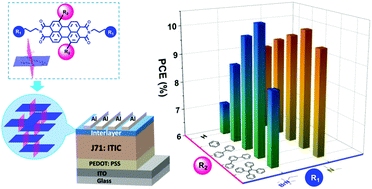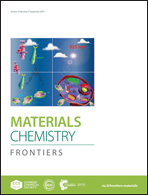Perylene diimide-based cathode interfacial materials: adjustable molecular structures and conformation, optimized film morphology, and much improved performance of non-fullerene polymer solar cells†
Abstract
Non-fullerene polymer solar cells (PSCs) have earned widespread attention on account of their distinct advantages, such as low-cost solution processability, tunable energy levels and suitability for large-scale production. Herein, a series of perylene diimide (PDI) derivatives with different sizes of side and terminal groups are developed and used as cathode interfacial layers (CILs) for conventional non-fullerene polymer solar cells. The regulation of molecular structures can change the film morphology and improve the device performance. Taking PDI-NBr without a side group as the reference, the device modified with P3P-NBr bearing m-terphenyl as the side group shows much increased power conversion efficiency (PCE) by 46% (7.14% versus 10.46%). Moreover, once the terminal group changes to amino N-oxide (NO), PSC based on P1P-NO with a suitable side group displays the champion PCE of 11.56% and much improved stability, providing a new method to optimize the interfacial materials for non-fullerene PSCs.



 Please wait while we load your content...
Please wait while we load your content...